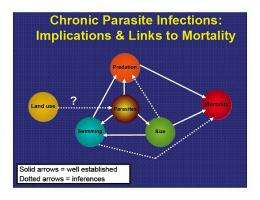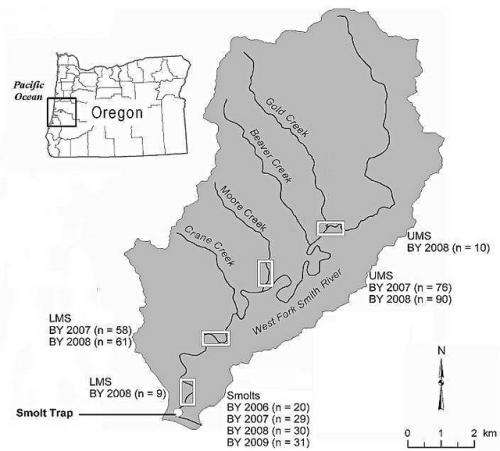Parasite loads an underlying cause of salmon mortality, linked to land use changes

A recent study suggests that parasites in fish, including threatened species of Oregon coho salmon, may have more profound impacts on fish health than has been assumed, and could be one of the key mechanisms by which habitat and land use changes cause salmon mortality.
It's not just the presence or absence of parasites that is important, the research found, but their numbers that can build up over years or decades and ultimately cause major impacts.
The study will be published soon in the journals Aquaculture, Journal of Parasitology, and International Journal of Parasitology. It was done by researchers from Oregon State University and other agencies, and concluded that heavy loads of parasites can affect salmon growth, weight, size, immune function, saltwater adaptation, swimming stamina, activity level, ability to migrate and other issues. Parasites drain energy from the fish as they grow and develop.
"We've known for a long time that salmon and other fish are affected by parasites, so that isn't new," said Mike Kent, an OSU professor of microbiology. "Because parasites have been present for decades, they have often been dismissed as a cause of increasing salmon mortality.
"But we're now getting a better appreciation that it's the overall parasite load that is so important," he said. "The higher levels of mortality only show up with significant increases in the parasite burden."

And that increase in parasite numbers, Kent said, is a slow, gradual response to warmer waters and heavier nutrient loads that can be a result of logging, agriculture, inadequate streamside protection and other land use or management changes over many years.
"Salmon can actually tolerate a fairly wide range of temperatures, it's not just the fact a stream is warmer that's killing them, in and of itself," he said. "We now believe that some of these forces are leading to heavier parasite loads. This could be important in understanding declining salmon populations."
Some of the digenean parasites that can infect salmon and other fish have complex life cycles, which include passage through the intestinal tracts of birds that eat fish, producing eggs and then infecting snails. Snails thrive in warmer water with higher nutrient loads from common fertilizers.
It's been historically difficult to study these issues in salmon, Kent said, because they migrate and cannot be easily analyzed, as fish can when they are trapped in a lake or pond.
In the new study, researchers did both laboratory and field analysis of fish in Oregon's West Fork Smith River. The impact of parasites on fish health were much more severe in a part of the river where water moved more slowly and nearby logging and agricultural practices increased water temperature and nutrient loads. Fish in this area had parasite infestations about 80 times higher than those higher up in the tributary.
The various impacts on fish health, the researchers said, could affect their ability to survive. Fish size influences juvenile overwinter survival, for instance, and swimming ability that's essential to avoiding predators.
"Understanding why certain salmon populations are heavily infected with these parasites, which likely are driven by landscape characteristics, could help in management or recovery planning," the scientists wrote in their conclusion, "given that our data indicates that severity of these infections are associated with survival."
Provided by Oregon State University

















